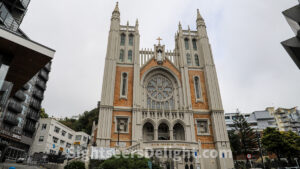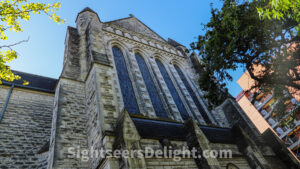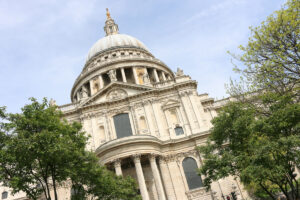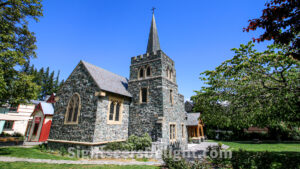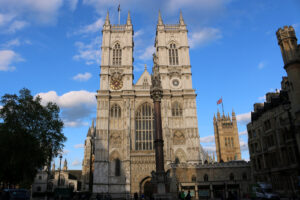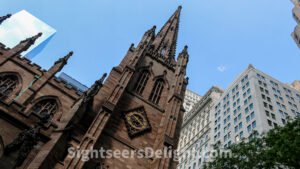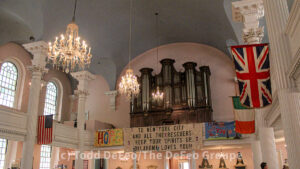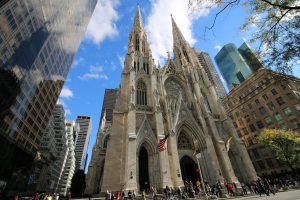St. Mary of the Angels sits on the site of Wellington’s first Catholic Church, established in 1843, and is the third church to occupy the site. The church opened on March 26, 1922, replacing a building that burned in May 1918. Construction started in April 1919, and the church’s contractor, H.E. Manning, went bankrupt during construction. Father Stanislaw Mahoney, the parish priest, and a close friend, Martin Maloney, worked with a group of largely unskilled workers to complete the church.
St Paul’s Cathedral, the mother church of the Diocese of London, is the seat of the Bishop of London. The original church was consecrated in 1300; the current church was consecrated in 1697. The 365-foot-tall edifice was the tallest building in London from 1710 to 1967, and its dome is among the highest in the world. It is the second-largest church building in area in the United Kingdom. Over the years, St Paul’s Cathedral has hosted several high-profile events, including the 1981 wedding of Prince Charles and Lady Diana Spencer and jubilee celebrations for Queen Victoria.
St. Peter’s was designed by an architect from Dunedin using Gothic details, but built along the lines of an English parish church. Anglican roots in Queenstown, however, date to at least 1861. An earlier church was built in 1863 and modified over the years. The oft-photographed stone church, which almost seems out of place in adreneline-driven modern Queenstown, seats 130 people.
The Collegiate Church of St Peter at Westminster, better known as Westminster Abbey, was built in the 10th century. British monarchs have held their coronations at Westminster Abbey since 1066. Among the artifacts on display is King Edward’s Chair (or St Edward’s Chair), the throne on which English and British sovereigns have been seated when crowned and has been used at every coronation since 1308. The Abbey has been the site of at least 16 royal weddings since King Henry I married Matilda of Scotland on Nov. 11, 1100.
The shrine was created to honor the spirits — or “kami” in Japanese — of the soldiers who died in the Boshin War of 1868-9. Soldiers who fought and died in subsequent wars until World War II have been enshrined here. However, no one who died in combat since the Second World War has been enshrined. To date, 1,068 people who were convicted of some classification of a war crime have been enshrined here; 14 are so-called “Class A” war criminals, making it one of the more controversial places to visit.
Old North Church is famous as the location where the message of “one if by land, two if by sea” was sent. In April 1775, Paul Revere told a trio of Boston patriots to hang two lanterns in the steeple to indicate British troops were approaching by sea. The church, built in December 1723, was inspired by the works of Christopher Wren, a British architect responsible for rebuilding London after the Great Fire.
02113
The historic Trinity Church is a parish church in the Episcopal Diocese of New York and located near the intersection of Wall Street and Broadway in Manhattan. The first Trinity Church was built on Wall Street in 1698 and faced the Hudson River. The building was destroyed in the Great Fire of 1776 during the Revolutionary War. In 1790, the second Trinity Church was completed and faced Wall Street. It featured a 200-foot-tall steeple. The third and current Trinity Church was built between 1839 and 1846.
10006
St. Paul’s Chapel was completed in 1766 as a “chapel of ease” for those who could not make it to the Parish of Trinity Church. Ten years later, the church survived the Great Fire of New York. In 1789, George Washington attended services here on Inauguration Day and continued to attend the church for two more years as the city served as the nation’s capital. Years later, on Sept. 11, 2001, the church was only yards away from the worst terrorist attack on American soil.
10007
The Neo-Gothic-style Roman Catholic St. Patrick’s Cathedral is perhaps the most recognized church in the United States. Construction of the cathedral began in 1858 but was halted during the Civil War. It resumed in 1865, and the cathedral was completed in 1878. It was dedicated on May 25, 1879. The church’s spires were added in 1888.
10022

